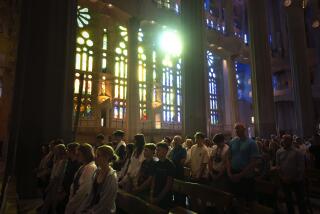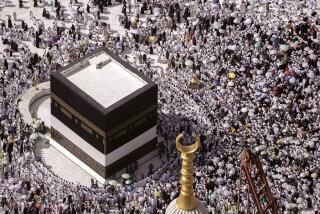Europe’s Largest Mosque Completed but Mostly Empty : Rome: Although some Muslims have prayed there, its consecration has been delayed for unexplained reasons.
- Share via
ROME — Standing in the heart of Christendom, Europe’s largest mosque is finally complete after 22 years.
But though some Muslims have prayed there for more than a year, it has yet to be consecrated officially and is empty most of the time.
The complex’s library has no books. The 500-seat meeting hall is silent. The house of worship itself is closed except on Fridays, and except for special occasions such as the feast celebrating the end of Ramadan, only a few hundred people attend prayers in a space that could hold 2,000.
Mosque officials will not comment on why it has not formally opened. But people knowledgeable about the mosque say a dispute over control between Saudi Arabia and Iraq and other countries, aggravated by the Gulf War, may be to blame. Saudia Arabia paid nearly half of the $45-million cost.
Other theories hold that the mosque’s administrators are waiting for an official visit from Saudi Arabia’s King Fahd or that the mosque is still trying to decide what role to play in Italy’s Muslim community.
Moroccan artisans in past months finished the painstaking mosaic work, the final touches on 10 years of construction. The mosque’s dome peaks 72 1/2 feet above the floor of the prayer area, and the minaret rises nearly 130 feet.
The structure, designed by Paolo Portoghesi to be the largest in Europe, is the most important architectural project in Rome in the last 30 years and has drawn praise for its beauty and stylistic melding of East and West.
But, as an institution, the mosque complex seems remote from the community it serves.
It is on the edge of the affluent Parioli district in a wide open space at the base of Monte Antenne, far from the city’s burgeoning population of more than 50,000 Muslim immigrants from North Africa and South Asia. There are an estimated 400,000 Muslims in Italy.
A bus reaches the mosque only on Fridays, the Muslim day of prayer. A long stone base holding the gate glides silently open to let in worshipers. Guards search bags. The doors to the center do not have handles on the outside.
“The presence of the mosque in the (lives) of immigrants is zero,” said Stefano Allievi, a University of Milan researcher studying Italy’s Islamic population. “That’s not its institutional role.”
Allievi pointed out that the mosque was conceived in 1973, when Muslim countries, led by the oil-rich Persian Gulf nations, were looking to establish a monumental Islamic symbol in the West. There was hardly any Muslim community in Rome to serve at the time.
But while most Muslims who live in Rome attend small prayer halls scattered around the city, the mosque has become a powerful symbol to the many poor and powerless Muslim immigrants across Europe, Allievi says.
They often quote to him one of the sayings of the prophet Mohammed, that after Constantinople--the Byzantine capital conquered by the Ottoman Turks--Rome will be opened to Islam.
The Islamic Cultural Center of Italy administers the mosque.
The center’s Moroccan director, Abdellatif el Kettani, graciously received a reporter recently but declined to answer questions unless he could photocopy the reporter’s notes. He said his comments and those of mosque religious leader Sheik Mahmoud had been distorted in the past.
Sitting in his office, where Saudi Arabian Airlines coasters rested on the coffee table, el Kettani disputed a suggestion that he seemed to feel defensive.
On a recent Monday the complex was deserted but for a few workmen hosing down the outside courtyard.
On Fridays, merchants from a cross-section of the Islamic world set up stands outside. Worshipers can buy dates, delicate pastries, pistachio nuts, Lebanese sausage and Egyptian beans. Another stand sells cassette tapes of Koran readings or popular sermons by fiery Egyptian preachers who condemn Israel and Western decadence.
More to Read
Sign up for Essential California
The most important California stories and recommendations in your inbox every morning.
You may occasionally receive promotional content from the Los Angeles Times.













